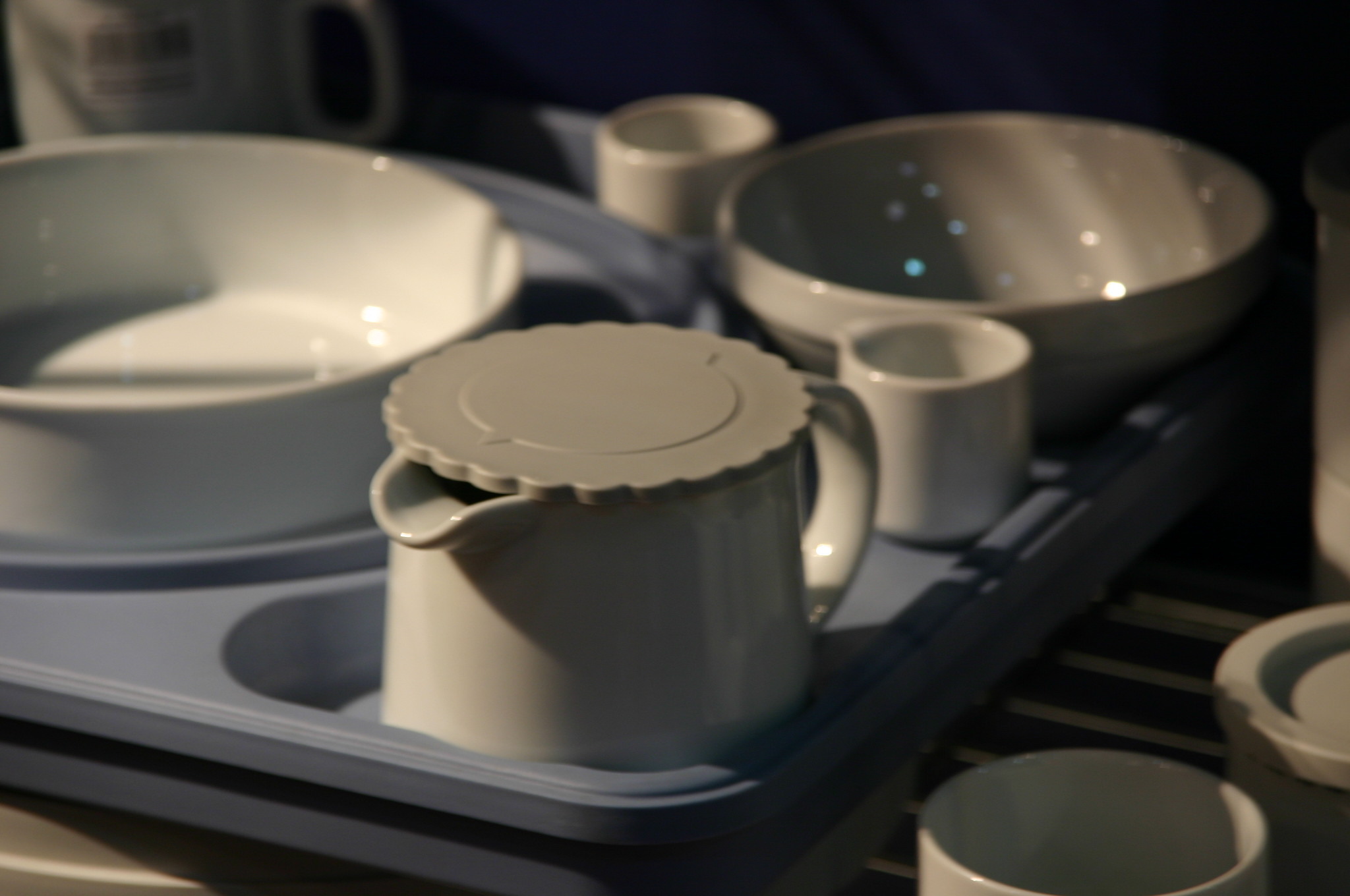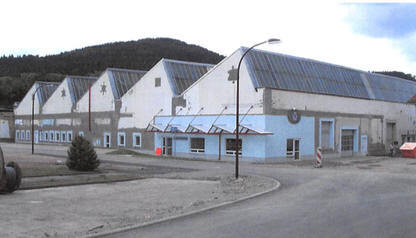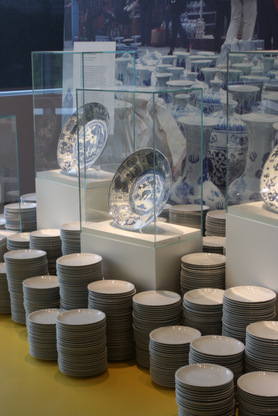System porcelain
System porcelain from Holst Porzellan

This page is still under construction (wv-kh)
Especially the catering industry expects a high degree of durability, functionality and a reasonable price from its porcelain. Due to the tough daily use, GM porcelain is subject to extreme conditions and has to withstand all thermal, chemical and mechanical loads in a large company. The basic requirements are stackability, heat storage, a secure supply and, above all, total conformity with all regulations, laws and provisions.
There are clear limits to the multitude of these suitability criteria with regard to a "stylish presentation". The design possibilities in terms of shaping with "stacking edge" and "butt edge" are simply far less than in our gastronomy collection, in which we can really play with unusual shapes and designs. Although GV porcelain is simple, its production is far more demanding than that of restaurant tableware.
The company chronicle of Porzellanfabrik Bauscher Weiden shows that it describes itself as the inventor of hotel porcelain and system tableware. It is undisputed that the well-known German industrial designer Heinz H. Engler designed the functional tableware B 1100 in 1959 for today's subsidiary of bhs-Tabletop AG, thus establishing a firm place for himself in the history of porcelain. In our opinion, Bauscher bears the name "world brand of hotel porcelain" quite rightly! The Hyatts, Hiltons and Sheratons of this world need such a premium brand in order to round off their own corporate design as an internationally operating chain with a brand; brand needs brand and brand maintenance costs money!
The majority of European porcelain brands, however, have not succeeded in covering their costs through the additional price of brand value creation. Almost all the big brands such as Hutschenreuther, Rosenthal, Ricardo Ginori or Wedgewood and many others ultimately had to sink their brand in bankruptcy.
In the 1980s, Holst already began to focus on the cost-conscious purchasing behaviour of commercial bulk consumers. We were very successful with the brand "Winterling Hotelporzellan" from 1968 to 1989. At that time we counted renowned bulk consumers such as Karstadt, Reiss, Käfer and Stockheim among our customers. Unfortunately, however, the Winterling Group also fell victim to the German porcelain demise at the beginning of the nineties.

The first stage of the 1992 health reform was probably the birth of our GV collection. Many companies could no longer afford expensive branded goods and manufacturers were called upon to find cheaper alternatives. But they did not budge and it seemed as if they simply wanted to sit out this change in values in Upper Franconia. So in 1996 we started to develop our own system crockery in Stadtlengsfeld, Thuringia, and started making moulds for plates and bowls to match the Caldotray compact system from Berndorf (today Blanco Berndorf). Renowned names such as the RWTH (Rheinisch-Westfälisch-Technische Hochschule in Aachen) were won as customers. A previously untouched monopoly was broken, and for the first time in the history of the Bauscher porcelain factory, its market power in the sector of "learned goods" was defeated by a small porcelain factory from Ilmenau.
Under the counter-pressure from Upper Franconia and heavily loaded with the inherited burdens of the GDR, the factory unfortunately had to give up and stop production at the end of 1998. So in 1999, with our moulds and our know-how, we set out again in search of a production alliance and found ourselves facing a completely sealed off German manufacturer monopoly. Attempts in Hungary, Romania and Poland to produce equally suitable porcelain failed. The Austrian Lily just gave up its production and moved the entire production to Dvory in the Czech Republic. The Swiss Langenthal and French Pillehuit were on the verge of their next bankruptcy and the Dutch Maastricht porcelain factory was completely unsuitable for this product of porcelain production. A test production in the Italian Civita Castellana brought us the knowledge of the "Deformatione professionale", the Spanish Rocca just made it onto a soap dish.
Benefiting from the IHK in Bielefeld and former Chancellor Kohl's favourite pupil Lars Windhorst, we succeeded in forming an alliance with an international industrial consortium in 2000, and we were able to continue our porcelain developments in Malaysia in 2001. It took a lot of time, effort and money until we delivered the first 20,000 stacking top cups to the relevant specialist retailers in August 2002 as the starting article of the Holst GM collection. With this, we confirmed our commitment to small series production (up to 500,000 pieces) in the more traditional, handcrafted manufacturing process and were thus able to put together a collection of more than one hundred special articles for canteens, catering and hospitals.
Almost ten years later, in June 2011, our system plate Katja was presented to the public in the "Cube" of the Berlin Humboldt Museum as a symbol for the further development of the East Asian porcelain tradition after a testing and selection process lasting several months. Thus the name Holst is unmistakably anchored in the history of porcelain!
Some representatives of German brand manufacturers (despise) us as cheap goods, "cinema porcelain" and inferior tableware. On closer inspection they are even right in some points! Our porcelain is cheaper than the fully machine-made, German goods and in terms of quality inferior to premium tableware just as a VW Golf is inferior to the Mercedes E or the Swatch watch of a Rolex. We are also not ashamed when we slow down the production cycle of the robot of a listed company and thus secure hundreds of fair jobs.
However, inferiority expresses a limited benefit for the user and that is just as wrong as if you were to slice China with a "K"! The GV porcelain from Holst Porzellan is dedicated to the cost-conscious bulk consumer, who under his own cost pressure must provide a constant and good performance. A sick person does not become healthier because he gets his food on a compartment plate from Bauscher and a pupil does not get better marks when he is served stew in a "Donna" from Schönwald. Our GV- & Systemporzellan is cheap, but not cheap, it is good and certainly not perfect.
It is simply... plain and strong!

In 2012, the European Commission carried out an investigation and came to the conclusion that tableware from Holst Porzellan is equivalent to German branded porcelain and, as a generic product, differs essentially only in price from that of the well-known brands. This illustrates how differently the claim of value, quality and price is perceived.
Today we are one of the leading suppliers of hospital porcelain and system tableware for conventional food distribution. In this category of goods we have taken our firm place with our "generic porcelain". We owe this to our customers and resellers, who have driven us forward in our endeavours to produce "affordable" system tableware - for which we would like to thank all those involved.
Yours sincerely
Knud Holst
